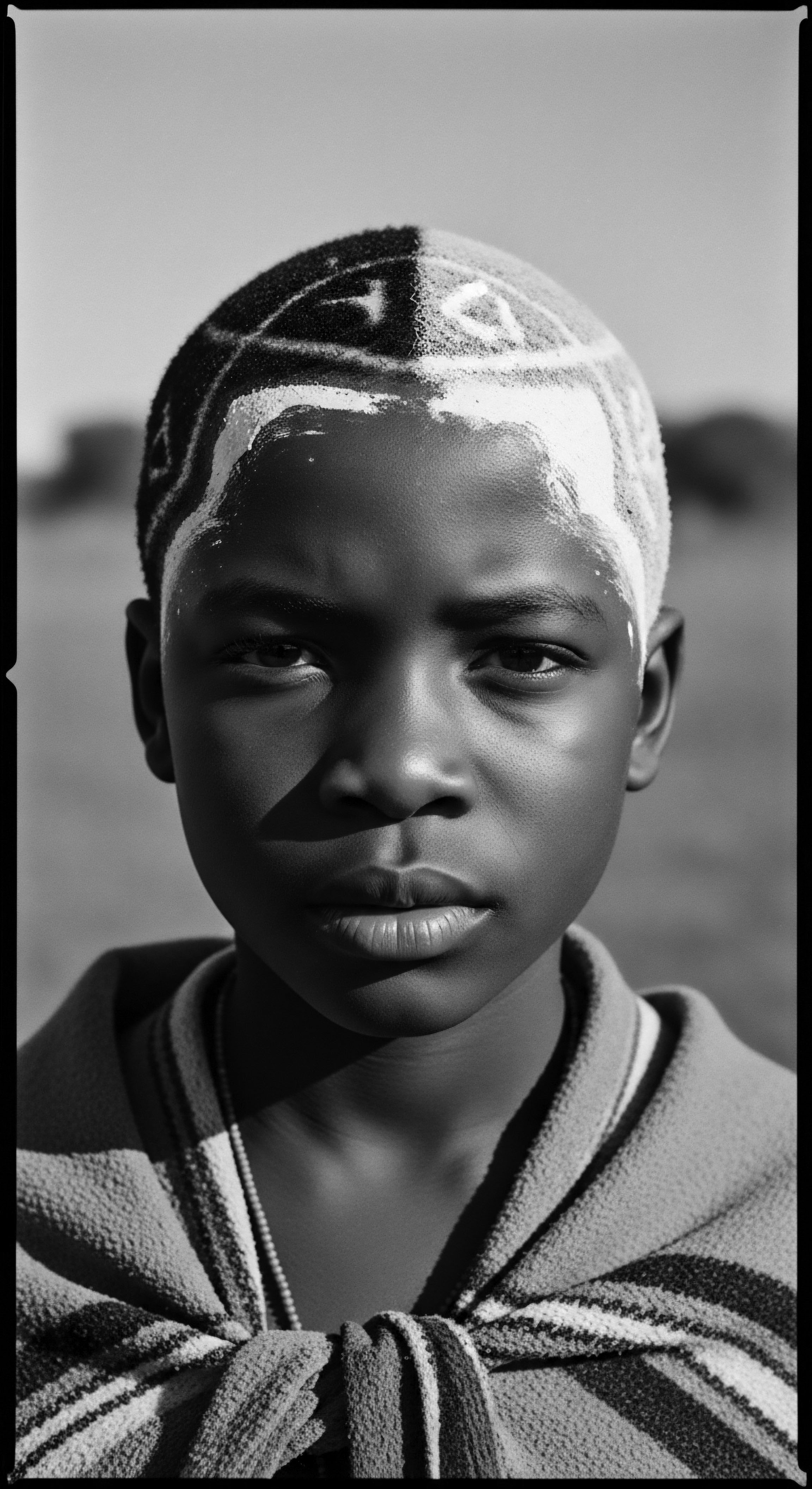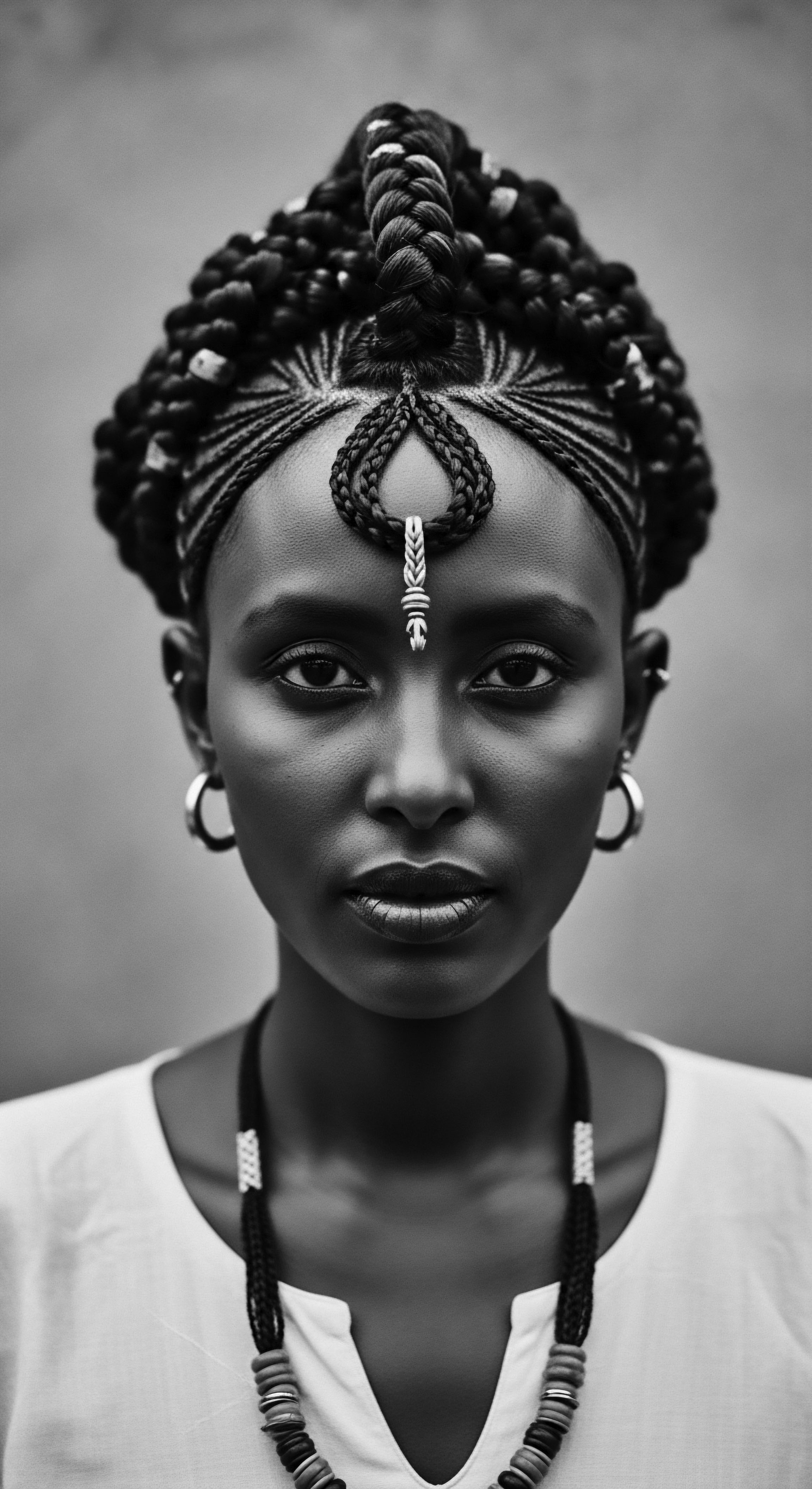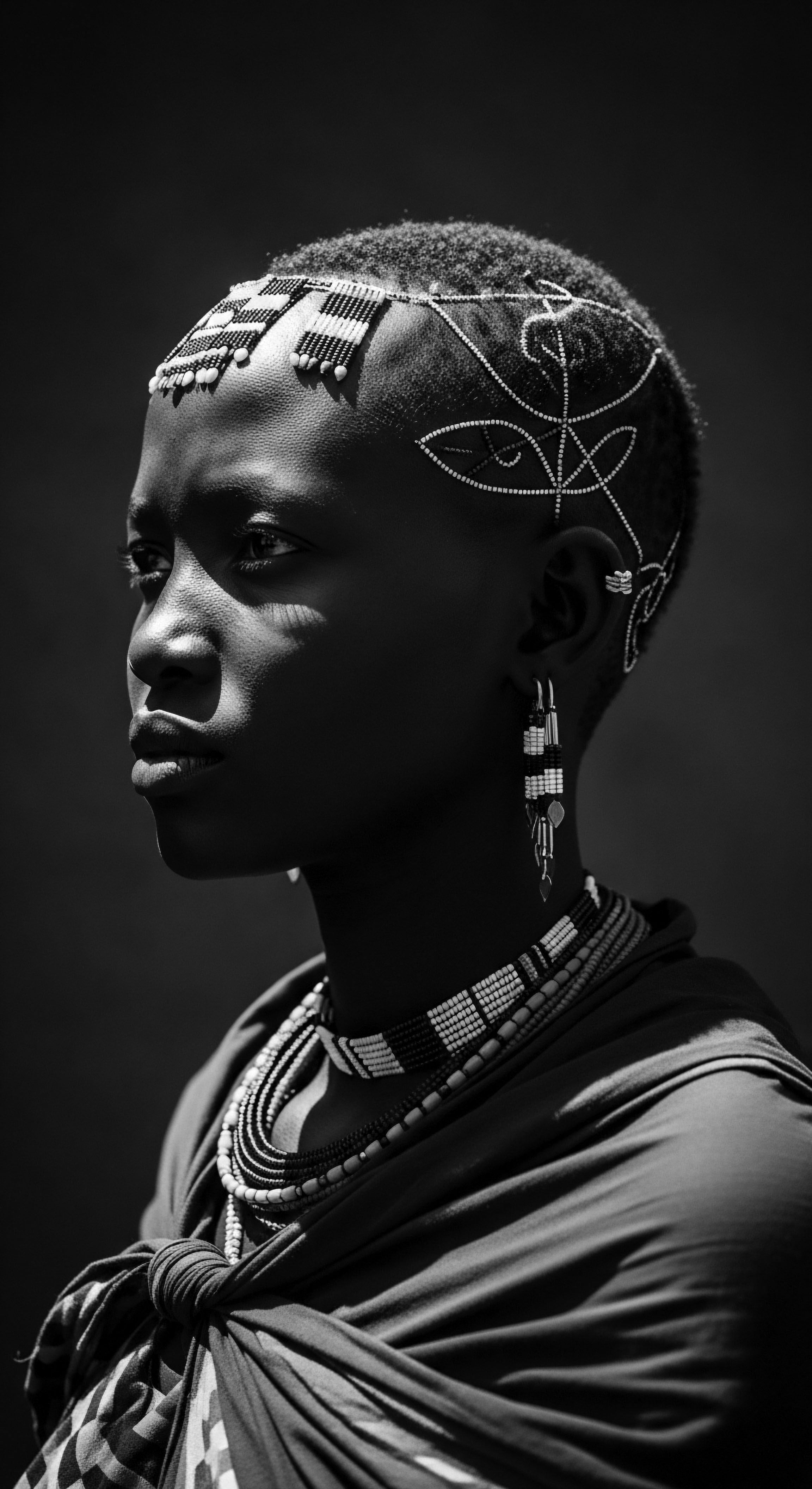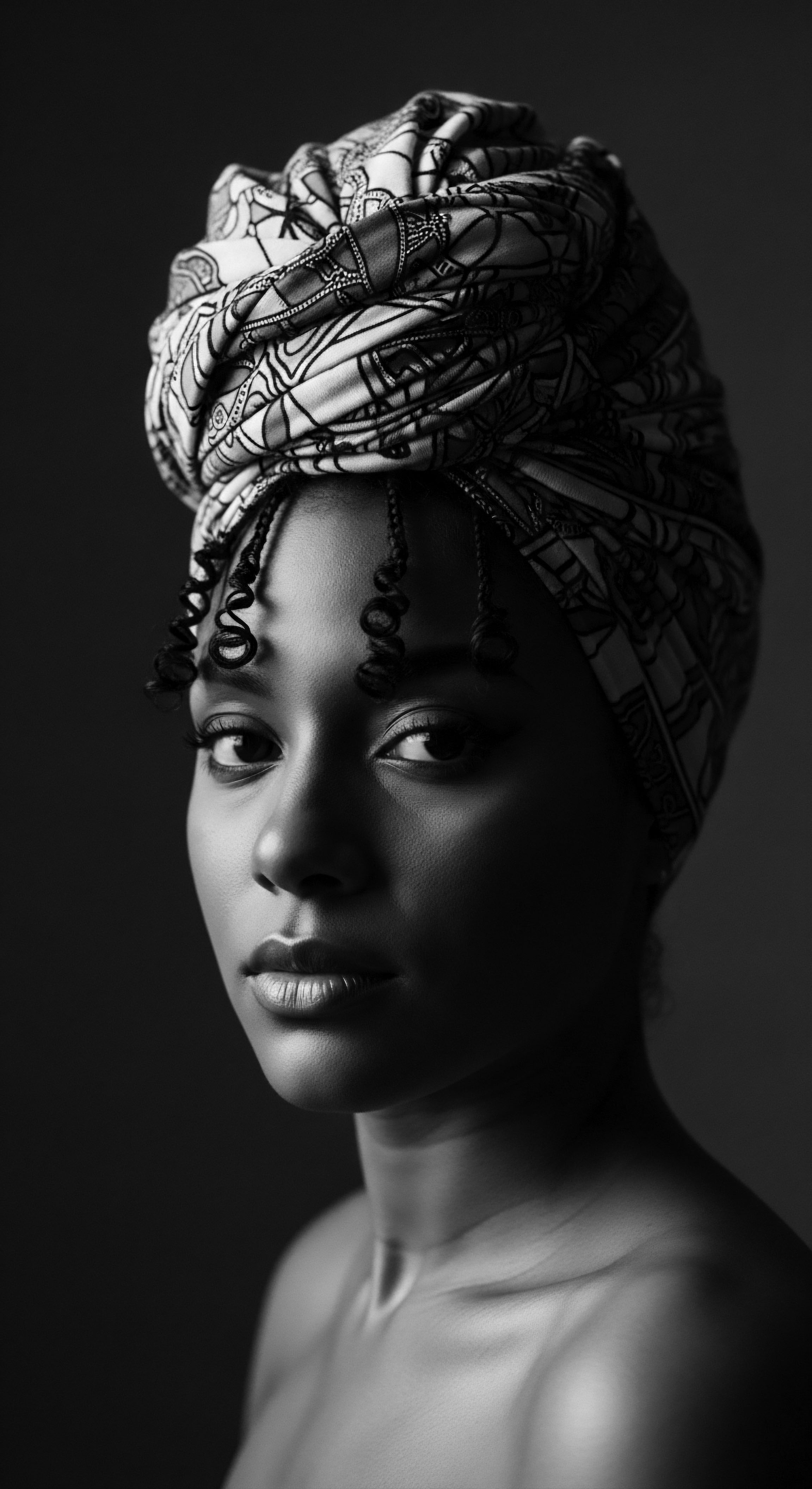
Fundamentals
The concept of ‘Botanical Preparations’ stands as a foundational pillar within the realm of holistic hair care, particularly for textured hair. At its simplest, a botanical preparation is any substance derived directly from plants—be it roots, leaves, flowers, seeds, barks, or fruits—that is intentionally crafted and applied for the purpose of cleansing, conditioning, adorning, or otherwise enhancing the health and appearance of hair. This definition, while straightforward, carries a rich historical and cultural weight, especially when viewed through the lens of textured hair heritage.
Consider the meaning embedded in these plant-based creations ❉ they are not merely ingredients; they are ancestral echoes. From the earliest communal rituals of hair grooming, communities across Africa and the diaspora turned to the abundance of their natural environments. They discovered, through generations of observation and practice, which flora possessed the inherent properties to moisturize a thirsty coil, to strengthen a delicate strand, or to impart a vibrant hue. This initial understanding, often passed down through oral tradition and lived experience, forms the very bedrock of what we now term botanical preparations.

The Elemental Origins of Hair Care
In its most fundamental sense, a botanical preparation for hair care is a direct connection to the earth’s living pharmacy. It involves the extraction of beneficial compounds from plants, whether through simple methods like steeping, crushing, or pressing, or more complex processes that have evolved over time. The purpose is consistently centered on hair wellness, which extends beyond mere aesthetics to encompass scalp health, hair resilience, and often, spiritual or communal well-being.
- Hydration Infusions ❉ Plant parts steeped in water or oils to create rinses or leave-in treatments, offering moisture and softening properties.
- Cleansing Agents ❉ Certain plant materials, like saponin-rich pods, traditionally used to gently cleanse the hair and scalp without stripping natural oils.
- Nourishing Balms ❉ Butters and oils pressed from seeds, providing essential fatty acids and vitamins for deep conditioning.
- Colorants and Dyes ❉ Pigment-rich plants employed to naturally alter hair color or enhance existing tones.
The inherent simplicity of these preparations belies their profound significance. They represent a harmonious relationship between humanity and the plant kingdom, a partnership forged in necessity and refined by ancestral wisdom. The very act of preparing these botanicals often became a ritual in itself, fostering connection and the transmission of knowledge across generations.
Botanical preparations are the earth’s whispers, translated into tangible care for the textured strands that carry the stories of our lineage.

Intermediate
Stepping beyond the fundamental, the intermediate understanding of Botanical Preparations deepens into their diverse applications and the traditional knowledge systems that underpin their use, particularly within the vast and varied tapestry of textured hair heritage. Here, the definition expands to acknowledge the specific preparation methods, the chemical compounds at play, and the cultural contexts that imbue these botanicals with their profound significance. The meaning of ‘Botanical Preparations’ here is less about the raw plant and more about the thoughtful transformation of natural elements into agents of care, beauty, and identity.

Preparation Methods ❉ Echoes from the Source
The journey of a botanical from its raw state to a hair preparation involves a spectrum of techniques, many of which have been practiced for centuries within Black and mixed-race communities. These methods are not arbitrary; they are meticulously developed to extract specific compounds, ensuring maximum efficacy and often, spiritual resonance.
- Infusions and Decoctions ❉ These involve steeping (infusions) or boiling (decoctions) plant material in water to extract water-soluble compounds. Think of herbal rinses from Rosemary or Hibiscus, traditionally used for scalp stimulation or to impart shine and strengthen hair. In West Africa, for instance, hibiscus (Hibiscus sabdariffa L.) has been a staple, used in hair treatments to promote growth and strengthen strands, often prepared as an herbal steam or rinse.
- Macerations and Oil Infusions ❉ This process involves soaking plant material in oils over time, allowing fat-soluble compounds to transfer. Oils like Coconut Oil or Castor Oil, staples in many diasporic hair care routines, often served as carriers for other botanicals. This method draws out beneficial lipids, vitamins, and antioxidants.
- Poultices and Pastes ❉ Crushing or grinding plant parts into a paste, often mixed with water or other liquids, allows for direct application to the scalp or hair. Henna (Lawsonia inermis L.), a natural dye, is a prime example, used not only for coloring but also for its conditioning and strengthening properties.
- Butters and Salves ❉ The rendering of plant fats, such as Shea Butter (Vitellaria paradoxa), represents a deeply rooted tradition. This rich, nourishing butter, often called “women’s gold” in West Africa due to its economic importance and the fact that its processing is largely controlled by women, has been used for centuries to moisturize and protect hair and skin from harsh climates.

The Science Beneath the Surface
While ancestral practices predated modern scientific understanding, contemporary research often affirms the wisdom embedded in these traditions. Botanical preparations contain a complex array of phytochemicals—bioactive compounds that interact with the hair and scalp.
For instance, the use of Hibiscus for hair health is supported by its content of amino acids and vitamin C, which contribute to strengthening hair strands and encouraging growth. Similarly, plants like Eclipta Alba (Bhringraj), a common ingredient in Ayurvedic hair preparations, are known for their ability to promote hair growth, strength, and even darkening of hair. These plant compounds, from antioxidants and anti-inflammatory agents to essential fatty acids and vitamins, work synergistically to address various hair concerns, from dryness and breakage to scalp irritation.
The traditional knowledge surrounding these plants is not merely anecdotal; it represents a vast, empirical dataset gathered over millennia. The consistent use of certain botanicals across diverse cultures speaks to their demonstrable efficacy, long before the advent of laboratories and chemical analyses.
The journey of a botanical from earth to textured hair care product is a testament to inherited wisdom, a silent affirmation of nature’s profound capacity for nurturing.

Cultural Significance and Ancestral Practices
The application of botanical preparations is rarely a solitary act; it is often interwoven with communal rituals and serves as a powerful expression of cultural identity. In many African communities, hair care routines are communal activities, strengthening bonds and preserving cultural heritage. This communal aspect transforms the simple act of hair care into a meaningful connection to lineage and shared history.
Consider the tradition of Shea Butter production, passed down from mother to daughter in West Africa. This is more than a recipe; it is a living legacy, embodying the resilience and ingenuity of generations. The hands that press the nuts, the songs sung during the process, and the stories shared all contribute to the profound cultural meaning of the final product.
The choice to use botanical preparations for textured hair today is often a conscious reclamation of this heritage, a decision to honor the wisdom of ancestors who understood the power of the earth’s gifts. It represents a statement of self-acceptance and pride in one’s unique hair journey.
The enduring use of specific plants like Aloe Vera, Coconut Oil, and Shea Butter across various African and diasporic communities for nourishing and protecting hair underscores their timeless value. These are not just ingredients; they are symbols of continuity, resilience, and a deep, abiding respect for the natural world.

Academic
The academic examination of ‘Botanical Preparations’ transcends simple definitions, delving into their intricate phytochemistry, ethnobotanical trajectories, and their profound sociopolitical implications within the context of textured hair, particularly for individuals of Black and mixed-race heritage. This scholarly interpretation posits botanical preparations not merely as natural products, but as complex bio-cultural artifacts, embodying centuries of indigenous knowledge, scientific discovery, and a persistent assertion of identity against prevailing beauty norms. The meaning of ‘Botanical Preparations’ at this level is a rigorous, multi-disciplinary analysis of their historical agency and contemporary relevance.

Phytochemical Complexity and Biological Mechanisms
From an academic standpoint, understanding botanical preparations necessitates a deep inquiry into their diverse chemical constituents and the mechanisms through which these compounds interact with the human integumentary system, specifically the hair follicle and shaft. These preparations are not single-compound remedies; they are often complex matrices of phytochemicals, including flavonoids, tannins, saponins, terpenes, alkaloids, and essential fatty acids, each contributing to a synergistic effect.
For example, the widespread traditional use of Eclipta Alba (Bhringraj) in Ayurvedic medicine for hair growth and preventing premature graying is supported by modern phytopharmacological studies identifying compounds like coumestans, triterpenes, and polypeptides as active constituents. These compounds are believed to influence hair growth cycles, strengthen hair follicles, and offer antioxidant protection. Similarly, the efficacy of Hibiscus (Hibiscus sabdariffa L.) in West African hair traditions, often applied as a rinse or oil, can be attributed to its alpha hydroxy acids (AHAs), amino acids, and vitamin C, which aid in gentle exfoliation of the scalp, strengthening hair, and promoting growth.
A significant aspect of this academic lens is the recognition that traditional therapies often operate on a systemic, nutritional level rather than a “magic bullet” paradigm, as sometimes seen in pharmaceutical approaches. This holistic perspective aligns with ancestral wisdom, where overall scalp health and hair vitality were seen as reflections of internal well-being, influenced by a balanced interaction with the natural world.

Ethnobotanical Trajectories and Cultural Resilience
The historical narrative of botanical preparations for textured hair is inextricably linked to ethnobotany – the study of how people of a particular region or culture use indigenous plants. This academic discipline reveals the meticulous accumulation of knowledge across generations, often through empirical trial and error, concerning the properties and applications of local flora.
Consider the profound historical example of Shea Butter. Its origins stretch back over 3,000 years in West and Central Africa, where it has been a cornerstone of skin and hair care, and even nutrition. Beyond its emollient properties, shea butter embodies economic empowerment for women in the “shea belt” of West Africa, who have traditionally controlled its production and trade, earning it the moniker “women’s gold.” This historical continuity, where the knowledge of shea processing is passed from mother to daughter, represents a tangible link to ancestral practices, even in the face of colonial disruptions and the transatlantic slave trade.
During these periods, enslaved Africans were often stripped of their cultural practices, including traditional hair care, as a means of dehumanization. Yet, the knowledge of botanicals, sometimes carried in braided hair (Byrd & Tharps, 2014), persisted, adapting and re-emerging as symbols of resilience and identity within the diaspora.
A notable study on ethnobotanical practices in Karia ba Mohamed, Northern Morocco, identified 42 plant species across 28 botanical families used for hair care. Among the most cited were Lawsonia Inermis L. (Henna) for strengthening, revitalizing, and coloring hair, and Rosa Centifolia L. (Rose) for anti-dandruff and hair growth. This demonstrates the localized, yet widespread, reliance on botanical knowledge for hair health across African communities.
Botanical preparations for textured hair are not merely historical footnotes; they are living testaments to cultural survival, encoded within the very strands of our collective memory.

Sociopolitical Dimensions and Identity Affirmation
Beyond their biological and historical attributes, botanical preparations carry significant sociopolitical weight for textured hair communities. The choice to use these traditional remedies is often a conscious act of resistance against Eurocentric beauty standards that have historically marginalized natural hair textures. The “natural hair movement” of recent decades, gaining momentum from the “Black is Beautiful” movement of the 1960s Civil Rights Era, is a powerful manifestation of this.
The re-emergence of natural hair styles, often nurtured with botanical preparations, signifies a re-alignment of identity with African heritage and the African diaspora. It is a reclaiming of self-definition, moving away from societal pressures that historically mandated chemical alteration of hair to conform to a dominant aesthetic. This is not just a personal aesthetic preference; it is a collective consciousness, fostering self-esteem and identity development, particularly for Black children.
The academic discourse acknowledges that these preparations are not just about superficial beauty. They represent a deep connection to ancestral wisdom, a tangible link to practices that sustained communities through adversity. The very act of applying a botanical oil or a herbal rinse becomes a ritual of self-care rooted in a legacy of resilience.
The ongoing research into the efficacy and safety of these traditional botanicals, often through ethnobotanical surveys and phytochemical analyses, serves to validate and honor this invaluable heritage, bridging ancient knowledge with contemporary scientific understanding. This validates what has been known and practiced for centuries, reinforcing the profound value of these preparations as more than just products, but as cultural anchors.
The study of botanical preparations for textured hair, therefore, is a vibrant interdisciplinary field. It combines the rigorous methodologies of botany and chemistry with the nuanced interpretations of anthropology and cultural studies. It asks not only “what does this plant do?” but also “what does this plant mean?” and “how has its use shaped and been shaped by human experience across time and space?” This holistic inquiry offers a truly comprehensive understanding of their enduring significance.

Reflection on the Heritage of Botanical Preparations
As we close this exploration of Botanical Preparations, we find ourselves standing at a crossroads where ancient wisdom meets the unfolding future of textured hair care. The journey through their elemental biology, living traditions, and their profound role in shaping identity reveals a truth that resonates deeply with the ‘Soul of a Strand’ ethos ❉ our hair is a living archive, and the botanicals we choose are its enduring script.
From the sun-drenched landscapes of West Africa, where Shea Butter was meticulously crafted by women, to the vibrant rituals of the Caribbean, where local herbs nourished coils and kinks, these preparations are more than products; they are echoes of hands that cared, voices that sang, and communities that thrived. The knowledge of which leaf to crush, which seed to press, or which flower to steep was not simply utilitarian; it was a sacred inheritance, passed down through generations who understood the intimate connection between nature’s bounty and human well-being.
The story of Botanical Preparations for textured hair is a story of profound resilience. It speaks to a people who, even when forcibly displaced and stripped of so much, held onto the threads of their cultural practices, weaving them into new forms of care and self-expression. The act of choosing a botanical preparation today is often a conscious, affirming step—a silent conversation with ancestors who used these very gifts of the earth to nurture their crowns.
It is a celebration of hair in its most authentic, textured glory, unburdened by external pressures and deeply rooted in its own magnificent history. This connection to ancestral wisdom, whether through a simple herbal rinse or a rich oil, reminds us that the path to true hair wellness is often found by looking back, allowing the wisdom of the past to illuminate our way forward.

References
- Byrd, A. D. & Tharps, L. D. (2014). Hair Story ❉ Untangling the Roots of Black Hair in America. St. Martin’s Griffin.
- Mouchane, M. Dandani, Y. Chaachouay, N. & Hmouni, D. (2024). Ethnobotanical Survey of Medicinal Plants used in the Treatment and Care of Hair in Karia ba Mohamed (Northern Morocco). Journal of Medicinal Plants Research, 18(3), 200-208.
- Sharaibi, O. J. Oluwa, O. K. Omolokun, K. T. Ogbe, A. A. & Adebayo, O. A. (2024). Cosmetic Ethnobotany Used by Tribal Women in Epe Communities of Lagos State, Nigeria. Journal of Complementary Medicine & Alternative Healthcare, 12(4), 555845.
- Kumar, S. & Kumari, R. (2021). ECLIPTA ALBA (BHRINGRAJ) ❉ A PROMISING HEPATOPROTECTIVE AND HAIR GROWTH STIMULATING HERB. International Journal of Applied Pharmaceutics, 14(7), 16-23.
- Tekalign, T. & Kebede, E. (2025). Plants used for hair and skin health care by local communities of Afar, Northeastern Ethiopia. Ethnobotany Research and Applications, 29, 1-15.
- Goyum Screw Press. (n.d.). Shea Butter Production, Benefits and Uses .
- Egyptra Travel Services. (2025). From Ancient Egypt to Modern Beauty ❉ Timeless Cosmetic Secrets.
- Omez Beauty Products. (2024). The Cultural Significance of Natural Hair.
- Thirteen Lune. (n.d.). Discovering the Cultural Heritage of Shea Butter.
- Velas Resorts. (2024). Velas Resorts Unveils New Wellness Offerings Where Ancestral Traditions Meet Modern Practices.
- Mobarak, R. (n.d.). About Us – Egyptian Botanicals.
- Clinikally. (2023). Hibiscus for Hair Growth ❉ Benefits, Uses and More.
- Google Patents. (n.d.). WO2006061847A1 – Herbal black dye used in beautifying the hair and its applications.
- MDPI. (2022). Recent Advancements in Natural Plant Colorants Used for Hair Dye Applications ❉ A Review.
- MDPI. (n.d.). Cosmetopoeia of African Plants in Hair Treatment and Care ❉ Topical Nutrition and the Antidiabetic Connection?
